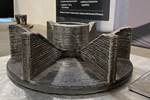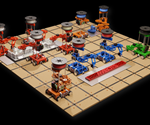When robots perform deposition-style 3D printing, adding more robots offers the chance to build large parts faster. The Medusa system developed at Oak Ridge National Laboratory’s Manufacturing Demonstration Facility combines three robots performing directed energy deposition (DED) metal additive manufacturing via Lincoln Electric Additive Solutions’ wire arc additive manufacturing process. The robots apply material in synchronized motion around a shared indexing turntable, and future versions of the system will add even more robots.
Related resources:
- Oak Ridge National Laboratory Manufacturing Demonstration Facility
- The way ahead for wire arc additive manufacturing
- Why additive manufacturing and robots go together
- Another example of coordinated 3D printing with multiple robots
Related Content
-
Chuck Jaws Achieve 77% Weight Reduction Through 3D Printing
Alpha Precision Group (APG) has developed an innovative workholding design for faster spindle speeds through sinter-based additive manufacturing.
-
How AM Enables Cobot Automation for Thyssenkrupp Bilstein (Includes Video)
The shock absorber maker has responded to its staffing shortages through extensive use of collaborative robots. In-house 3D printing makes this possible by providing the related hardware needed to complete the cobot-automated cells.
-
Video: 3D Printed Tooling Eases Cobot Integration
At NPE 2024, Universal Robots and EMI Corporation highlighted how 3D printed end effectors, fixtures and more enable adoption of collaborative robots.












